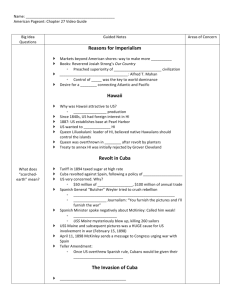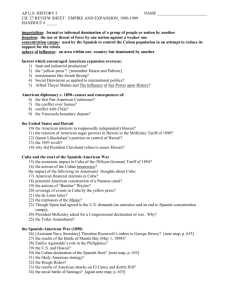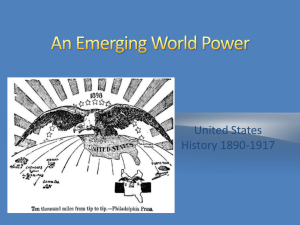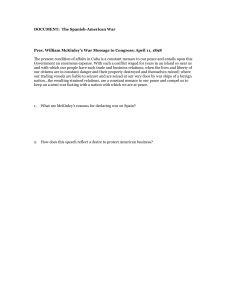Chapter 27 - s3.amazonaws.com
advertisement
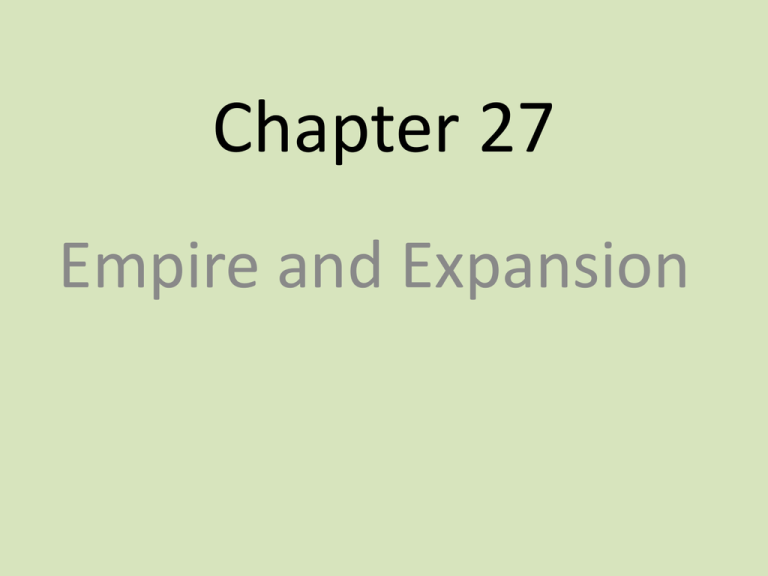
Chapter 27 Empire and Expansion • Civil War to the 1880s - US was very isolationist • 1890s - rising exports, manufacturing capability, power, and wealth – Began to expand onto the world stage, using overseas markets to sell its goods. • The “yellow press” or “yellow journalism” of Joseph Pulitzer and William Randolph Hearst influenced overseas expansion • Missionaries inspired by Reverend Josiah Strong’s Our Country: It’s Possible Future and Its Present Crisis – Our duty to civilize and Christianize savages – Darwin’s theory of survival-of-the-fittest - the United States was the fittest and needed to take over other nations to improve them. • Europeans had carved up Africa and China by this time. • In America, Captain Alfred Thayer Mahan’s 1890 book, The Influence of Sea Power Upon History, 1660-1783, argued that every successful world power once held a great navy. – Helped start a naval race among the great powers and moved the U.S. to naval supremacy – Motivated the U.S. to look to expanding overseas. • James G. Blaine’s “Big Sister” policy sought better relations with Latin America • 1889 - presided over the 1st Pan-American Conference (Washington D.C.) US Becomes Aggressive • America and Germany almost went to war over the Samoan Islands (naval base) • Italy and America almost fought due to the lynching of 11 Italians in New Orleans • U.S. and Chile almost went to war after the deaths of two American sailors at Valparaiso in 1892. • U.S. and Canada argued over seal hunting near the Pribilof Islands off the coast of Alaska. Strengthening the Monroe Doctrine • An incident with Venezuela and Britain wound up strengthening the Monroe Doctrine. – British Guiana and Venezuela had been disputing their border for many years, but when gold was discovered, the situation worsened. – Thus, the U.S., under President Grover Cleveland, sent a note written by Secretary of State Richard Olney to Britain informing them that the British actions were trespassing on the Monroe Doctrine and that the U.S. controlled things in the Americas. – The British replied by stating that the affair was none of the U.S's business. – Cleveland angrily replied by appropriating a committee to devise a new boundary and if Great Britain would not accept it, then the U.S. implied it would fight for it. – Britain didn’t want to fight because of the damage to its merchant trade that could result, the Dutch Boers of South Africa were about to go to war and Germany’s Kaiser Wilhem was beginning to challenge Britain's power. – Seeing the benefits of an alliance with the "Yankees," Great Britain began a period of "patting the eagle's head," instead of America "twisting the lion's tale." This was referred to as the Great Rapprochement or reconciliation. Acquiring Hawaii • 1820s first U.S. missionaries landed in Hawaii • Treaties signed in 1875 and 1887 guaranteed commercial trade and U.S. rights to Pearl Harbor - Hawaiian sugar was very profitable • 1890 - McKinley Tariff raised the taxes on sugar – Americans wanted to annex Hawaii (opposed by Queen Liliuokalani) – 1893 - Americans in Hawaii revolted and won – They succeeded, and Hawaii seemed ready for annexation – Grover Cleveland became president again, investigated the coup, found it to be wrong, and delayed the annexation of Hawaii until he left office. – Cleveland was bombarded for stopping “Manifest Destiny,” but his actions proved to be honorable for him and America. Cuba in Revolt • 1895 - Cuba revolted against Spain (years of misrule) – Cubans torched their sugar cane fields – Hoped destruction would either make Spain leave or America interfere (the American tariff of 1894 had raised prices on it anyway) • Sure enough, America supported Cuba, and the situation worsened when Spanish General Valeriano “Butcher” Weyler came to Cuba to crush the revolt and ended up putting many civilians into concentration camps where many were killed • American public wanted to help, especially when spurred on by the yellow press, but Cleveland would do nothing. Yellow Journalism and The Mystery of the Maine – The yellow presses competed against each other to come up with more sensational stories, and Hearst even sent artist Frederick Remington to draw pictures of often-fictional atrocities. • Drew Spanish officials brutally stripping and searching an American woman (Spanish women, not men, did such acts) • February 9, 1898, a letter written by Spanish minister to Washington Dupuy de Lôme ridiculed President McKinley was published by Hearst. – February 15th, 1898 - U.S. battleship U.S.S. Maine mysteriously exploded in Havana Harbor, killing 260 officers and men. • Unknown cause, but America was war-mad, so Spain received the blame. • Hearst said of Cuba, “You supply the pictures, I’ll supply the story.” • Actually, an accidental explosion had blown up the ship (same explanation Spanish investigators gave but America ignored them) • American public wanted war • McKinley didn’t like war or the violence, since he had been a Civil War major. • Mark Hanna and Wall Street thought war would upset business. Declaring War and the Teller Amendment • April 11, 1898, the president sent his war message to Congress anyway, since: (1) war with Spain seemed inevitable, (2) America had to defend democracy, and (3) opposing a war could split the Republican party and America. • Congress adopted the Teller Amendment - when the U.S. had overthrown Spanish misrule, it would give the Cubans their freedom and not conquer it • Start of the Spanish-American War Taking the Phillipines • Spanish had the advantage over the U.S., more troops and a supposedly better army, as well as younger (and seemingly more daring) generals. • Navy Secretary John D. Long and his assistant secretary, Theodore Roosevelt had modernized the U.S. navy, making it sleek and sharp. – February 25, 1898 - Roosevelt commanded Commodore George Dewey (head of the American Navy at Hong Kong) and told him to take over the Philippines. – Dewey did so brilliantly, completely taking over the islands from the Spanish. • Dewey had naval control, but he could not storm the islands and its fortresses, so he had to wait for reinforcements – Other nations were moving their ships into Manila Harbor to protect their men. – The German navy defied American blockade regulations, and Dewey threatened the navy commander with war, but luckily, this episode blew over, due in part to the British assistance of America. • August 13, 1898 - American troops arrived and captured Manila, collaborating with Filipino insurgents, led by Emilio Aguinaldo, to overthrow the Spanish rulers. • July 7, 1898 - the U.S. annexed Hawaii (so that it could use the islands to support Dewey, supposedly), and Hawaii received full territorial status in 1900. Fighting in Cuba • Spanish sent warships to Cuba, panicking Americans on the Eastern seaboard, and the fleet, commanded by Admiral Cervera, found refuge in Santiago harbor, Cuba. – Blockaded by a better American force. • American ground troops, led by fat General William R. Shafter, were not ready for combat in the tropical environment (i.e. they had woolen long underwear). • The “Rough Riders,” a regiment of volunteers led by Theodore Roosevelt and Colonel Leonard Wood, rushed to Cuba and battled at El Caney stormed up San Juan Hill. • Admiral Cervera was finally ordered his navy to fight the American fleet, and his fleet was destroyed. • On land, the American army, commanded by General Nelson A. Miles, met little resistance as they took over Puerto Rico. • August 12, 1898 - Spain signed an armistice. • Had the Spaniards had held out for a few more months, they might have won – American army was plagued with dysentery, typhoid, and yellow fever. – Finally, TR wrote a “round-robin” letter demanded that the U.S. government take the troops out before they all died. Treaty of Paris (1898) • • • In negotiations in Paris, America got Guam and Puerto Rico and freed Cuba The Philippines were a problem - America couldn’t give it back to Spain after decades of misrule, but the U.S. couldn’t just take it McKinley decided to keep the Philippines, even though they had been taken one day after the end of the war – Popular public opinion and it meshed well with business interests. – The U.S. paid $20 million for the islands. • • Upon the U.S. taking of the Philippines, uproar broke out, since until now, the United States had mostly acquired territory from the American continent, or areas with few people (Alaska, Hawaii, and the other scattered islands) Anti-Imperialist League began to oppose this new imperialism of America – Members included Mark Twain, William James, Samuel Gompers, and Andrew Carnegie. – Even the Filipinos wanted freedom, and denying that to them was un-American. • Expansionists cried that the Philippines could become another Hong Kong. – British writer Rudyard Kipling wrote about “The White Man’s Burden,” urging America to keep the Philippines and “civilize them.” • Treaty was almost not passed by the Senate – William Jennings Bryan argued for its passage, saying that the sooner the treaty was passed, the sooner the U.S. could get rid of the Philippines. – The treaty passed by only one vote. Results of the Spanish-American War • Lasted only 113 days • Affirmed America’s presence as a world power. • However, America’s actions after the war made its German rival jealous and its Latin American neighbors suspicious. • Happiest results of the war: reunifying the North and South after the Civil War – General Joseph Wheeler (Southerner) was given a command in Cuba. Puerto Rico and Cuba • Foraker Act of 1900 – Gave Puerto Ricans a limited degree of popular government – 1917 - Congress granted Puerto Ricans full American citizenship. – U.S. helped transformed Puerto Rico and worked wonders in sanitation, transportation, beauty, and education. • The Insular Cases – Supreme Court ruled that the Constitution did not have full authority on how to deal with the islands (Cuba and Puerto Rico) – Cases said the island residents do not necessarily share the same rights as Americans – Allowed Congress to do whatever it wanted with them • America could not improve Cuba that much however, other than getting rid of yellow fever with the help of General Leonard Wood and Dr. Walter Reed. – 1902 - U.S. freed Cuba – Encouraged Cuba to write and pass the Platt Amendment, which became their constitution. • The U.S. could intervene and restore order in case of anarchy • U.S. could trade freely with Cuba • U.S. could get two bays for naval bases (including Guantanamo Bay) Dealing with the Philippines • The Filipinos had assumed that they would receive freedom after the Spanish-American War - when they didn’t they revolted against the U.S. – Began on February 4, 1899 – Led by Emilio Aguinaldo, used guerrilla warfare (open combat proved useless) – Stories of atrocities abounded – Rebellion was broken in 1901 when U.S. soldiers invaded Aguinaldo’s headquarters and captured him. • President McKinley formed a Philippine Commission in 1899 to deal with the Filipinos – Headed by William Howard Taft who developed a strong attachment for the Filipinos – Called them his “little brown brothers.” • Americans tried to assimilate the Filipinos, but the islanders resisted • Philippines became independent on July 4, 1946 China • Following its defeat by Japan in 1894-1895, China had been carved into “spheres of influence” by the European powers. • Americans worried – Churches worried about their missionary strongholds – Businesses feared that they would not be able to export their products to China. • Secretary of State John Hay sent the Open Door note – Urged the European nations to keep fair competition open to all nations willing and wanting to participate - “Open Door Policy” – Countries already holding spots of China were resistant • Only Italy (had no sphere of influence) accepted unconditionally – Russia didn’t accept it at all, but the others did • 1900 - super-patriotic group known as the “Boxers” started the Boxers’ Rebellion – Revolted and took over Beijing – Took all foreigners hostage, including diplomats. • Multi-national force broke the rebellion and made China pay $333 million for damages – U.S. received $18 million • Fearing that the European powers would carve China up for good, now, John Hay officially asked that China not be carved. Election of 1900 • McKinley did not actively campaign, but his vicepresidential candidate, Teddy Roosevelt, did • William Jennings Bryan ran against McKinley (again) • Bryan’s supporters concentrated on imperialism— Americans were tired of the subject • McKinley’s supporters claimed that “Bryanism” was the problem – If Bryan became president, he would shake up the prosperity that was in America at the time • McKinley won easily Theodore Roosevelt • Six months later, a deranged murderer shot and killed William McKinley, making Theodore Roosevelt the youngest president ever at age 42. – Promised to carry out McKinley’s policies. • Roosevelt was a barrel-chested man with a short temper, large glasses, and a stubborn mentality that always thought he was right. – Born into a rich family and graduated from Harvard – Highly energetic and spirited – His motto was “Speak softly and carry a big stick,” or basically, “Let your actions do the talking.” • • Rapidly developed into a master politician, who could not be controlled political machines Believed that a president should lead, which would explain the precedents that he would set during his term, becoming the “first modern president.” The Need for a Canal • TR had traveled to Europe and knew more about foreign affairs than most of his predecessors • Knew there need to be a canal through the Central American isthmus – During the Spanish-American War, the battleship U.S.S. Oregon had been forced to steam all the way around the tip of South America to join the fleet in Cuba. – Would make defense of the recent island acquisitions easier (i.e. Philippines, Puerto Rico, Guam, Hawaii). • Clayton-Bulwer Treaty (1850) with Britain had forbade the construction by either country of a canal in the Americas without the other’s consent and help – Nullified in 1901 by the Hay-Pauncefote Treaty • A Nicaraguan route was one possible place for a canal, but it was opposed by the old French Canal Company that was eager to build in Panama and salvage something from their costly failure there. – Their leader was Philippe Bunau-Varilla. – U.S. chose Panama after Mount Pelée (in Nicaragua) erupted and killed 30,000 people Acquiring the Land • U.S. negotiated a deal that would buy a 6-mile-wide strip of land in Panama for $10 million and a $250,000 annual payment – Treaty was retracted by the Colombian government, which owned Panama. – TR was furious, since he wanted construction of the canal to begin before the 1904 campaign. • TR and the U.S. decided enough was enough and it was time for action. – November 3, 1903 - revolution in Panama began with the killing of a Chinese civilian and a donkey – Colombia tried to stop it, but the U.S. (citing an 1846 treaty with Colombia) wouldn’t let the Colombian fleet through. – Panama’s independence was recognized by the U.S., and fifteen days later, Bunau-Varilla, the Panamanian minister despite his French nationality, signed the Hay-Bunau-Varilla Treaty that gave a widened (6x10 mi.) Panamanian zone to the U.S. for $15 million. Building the Canal • TR didn’t actively plot to tear Panama away from Colombia • Latin America was suspicious of how the US had gotten the land for the canal • 1904 - construction began on the canal – Problems with landslides and sanitation – Colonel George Washington Goethals organized the workers – Colonel William C. Gorgas exterminated yellow fever. – When TR visited Panama in 1906, he was the first U.S. president to leave America for foreign soil. – The canal was finally finished and opened in 1914, at a cost of $400 million. Roosevelt Corollary • Latin American nations (Venezuela and the Dominican Republic) were having a hard time paying their debts to European countries, so Britain and Germany decided to send force to South America to make them pay. • TR feared that if European powers interfered in the Americas to collect debts, they might then stay in Latin America, a blatant violation of the Monroe Doctrine • Issued the Roosevelt Corollary – Stated that in future cases of debt problems, the U.S. would take over and handle any intervention in Latin America on behalf of Europe, thus keeping Europe away and the Monroe Doctrine intact. – It said in effect, no one could bully Latin America except the U.S. – Didn’t sit well with Latin America -that the US was being overbearing • U.S. Marines landed in Cuba to bring back order to the island in 1906, this seemed like an extension of the “Bad Neighbor” policy. Roosevelt as a Peace Maker • 1904 - Japan attacked Russia in Manchuria – Japan was winning until they began to run short on men – Approached Theodore Roosevelt to facilitate a peace treaty. – Portsmouth, New Hampshire (1905), both sides met and were stubborn • Japan wanted all of the island of Sakhalin • Russians wanted part of it • TR negotiated a deal in which Japan got half of Sakhalin but no payment for its losses. – For this, and his mediation of North African disputes in 1906 through an international conference at Algeciras, Spain, TR received the Nobel Peace Prize in 1906. • However, due to the Russo-Japanese incident, America lost two allies in Russia and Japan, neither of which felt that it had received its fair share of winnings. Gentlemen’s Agreement • After the war, many Japanese immigrants poured into California – Americans thought they were trying to take over • 1906 - after an earthquake, San Francisco decreed that, due to lack of space, Chinese, Japanese, and Korean children should attend a special school. – Instantly became an international issue, but TR settled it eventually with the “Gentlemen’s Agreement” – San Francisco would not displace students while Japan would keep its laborers in Japan. • To impress the Japanese, Roosevelt sent his entire battleship fleet, “The Great White Fleet,” around the world for a tour, and it received tremendous salutes in Latin America, New Zealand, Hawaii, Australia, and Japan, helping relieve tensions. • The Root-Takahira Agreement pledged the U.S. and Japan to respect each other’s territorial possessions in the Pacific and to uphold the Open Door Policy in China.


